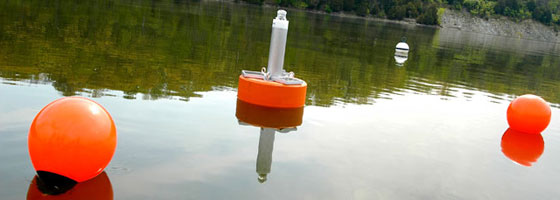Aquatic Classroom: students learn the future of their field on Acton Lake

Located just minutes from Miami University in Oxford, Ohio, the tranquil and accessible Acton Lake is the perfect training grounds for undergraduate and graduate students studying limnology.
Not only is the site close to campus, it also has a large watershed that makes it responsive to environmental disturbances and has a long-term data set for reference. The university even has access to a boat in the lake, allowing students to take classes out on the water and learn about lake ecology firsthand.
The reservoir serves as the emergency drinking water supply for the city of Oxford, is a productive fisheries site, and has been the site for ongoing research for decades. Because the watershed around Acton Lake predominantly consists of agriculture, the streams and rivers that flow into the lake can bring in large concentrations of sediments and nutrients during storms, stimulating harmful algal blooms, hurting fisheries, and reducing the lake’s water quality.
“With runoff, you get a lot of different effects,” said Kevin Rose, a PhD candidate in Miami University’s Department of Zoology.
“Agricultural runoff includes suspended solids from the tilling of the fields as well as a lot of fertilizer,” he said. “In addition to the algal blooms that can be caused by the fertilizer, the increase in suspended solids will change the colors of the lake. Over time, it will also fill in the reservoir, making it necessary to dredge.”
This spring, a research and monitoring buoy was purchased with a grant to Miami University and Kent State University to help students in the field, including Rose, study lake ecology as well as understand how landscape level processes and land use affect water quality. The system will also contribute to a long-term monitoring program. The grant was funded by the National Science Foundation, using stimulus money from the American Recovery and Reinvestment Act.
The platform delivers streaming real-time data, providing researchers and students with insight into the lake’s physics, chemistry, and biology and how they interact.
A NexSens MB-300 buoy was selected for the application. Fondriest technicians accompanied Rose and two other graduate students this spring to deploy the buoy, which was placed at the deepest point in the lake (25 feet) near the dam and anchored with a two-point mooring system.
The buoy’s center housing contains a NexSens SDL500 data logger with cellular telemetry. Sensors include a T-Node temperature string and a YSI 6600 V2-4 multi-parameter sonde with pH/ORP, conductivity, dissolved oxygen, optical chlorophyll, phycocyanin, and turbidity sensors.
The students also installed a meteorology station on shore near the buoy. The weather station allows researchers to respond to rain events that cause plumes of turbidity in the lake.
“When there’s a plume, you can physically see the brown water moving through the lake,” Rose said. “The rain sensor gives us a heads up, and we can then measure turbidity and nutrient levels in and around the plume.”
The weather data, particularly wind speed, also helps researchers understand gas fluxes and carbon cycling in the water. Boaters can use the information, too, to see current conditions on the lake.
The buoy and weather station data loggers transmit information back to the university, allowing scientists and students to observe changes in water quality and weather parameters in real time.
This real-time data access means researchers can now conduct adaptive sampling. For example, when a recent toxic algal bloom occurred, the phycocyanin sensor detected it. Then, based on pre-determined settings, NexSens iChart software automatically text messaged researchers as the bloom grew. Thanks to this real-time notification, scientists were able to visit the lake to conduct more intensive research on what was occurring underwater.
Prior to installing the real-time system, the students collected data every two weeks from a sonde in the lake that logged sensor readings internally. The old setup made it almost impossible to get samples from such an algal bloom event, Rose said.
“The algal bloom toxin levels spike and drop rapidly. It’s difficult to hit that peak,” he said. “Unless you see that bloom in real time, you might not know it’s even there.”
The streaming data has even been made publicly available via the Internet, allowing people interested in visiting the lake and anyone else to see information about water temperature, weather, and water quality. Rose said this public access has fostered a greater public understanding about the lake.
“It facilitates a better form of outreach to the community about what happens around the lake and what that does to it,” Rose said. “The data generated by the buoy provides people with a unique insight into what is happening underwater, and this better connects the science with the community.”
The ongoing research and monitoring has stimulated new avenues of research for scientists and provided students with an invaluable learning tool.
Rose said working with the real-time monitoring system will also give him and the other graduate students the big picture on the future of their profession. The experience, he said, will teach them to utilize cyber infrastructure, effectively manage large data sets, and work with the sensors and technology that have become vital for field research.
“The whole field of ecology is moving to more sensor driven, more high frequency, more large scale network based science,” Rose said. “This sort of training and research provides the opportunity to learn in an atmosphere that represents the future for ecology.”





0 comments